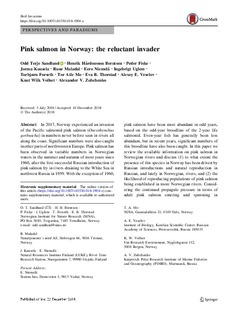| dc.description.abstract | In 2017, Norway experienced an invasion
of the Pacific salmonid pink salmon (Oncorhynchus
gorbuscha) in numbers never before seen in rivers all
along the coast. Significant numbers were also caught
in other parts of northwestern Europe. Pink salmon has
been observed in variable numbers in Norwegian
waters in the summer and autumn of most years since
1960, after the first successful Russian introduction of
pink salmon fry in rivers draining to the White Sea in
northwest Russia in 1959. With the exception of 1960,
pink salmon have been most abundant in odd years,
based on the odd-year broodline of the 2-year life
salmonid. Even-year fish has generally been less
abundant, but in recent years, significant numbers of
this broodline have also been caught. In this paper we
review the available information on pink salmon in
Norwegian rivers and discuss (1) to what extent the
presence of this species in Norway has been driven by
Russian introductions and natural reproduction in
Russian, and lately in Norwegian, rivers, and (2) the
likelihood of reproducing populations of pink salmon
being established in more Norwegian rivers. Considering
the continued propagule pressure in terms of
adult pink salmon entering and spawning in Norwegian rivers, it is puzzling that self-propagating
populations apparently only have been established in
some rivers in the northernmost part of the country.
The potential impact of pink salmon on native
salmonids and river ecosystems is discussed briefly.
Extensive research is required to understand the
mechanisms that determine the fate of pink salmon
as an alien species, and specifically the possible
impact of pink salmon on native salmonids and the
environment in the recipient rivers and in the ocean. | nb_NO |

